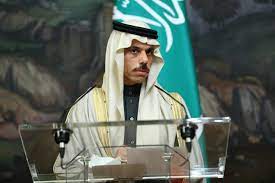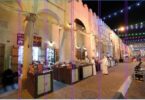Zaid M. Belbagi
The Saudi Ministry of Foreign Affairs is a hive of diplomatic activity. Among the less obvious facets of the Kingdom’s wider transformation in recent years has been the gear change in its foreign policy as it recalibrates to a multipolar world. Courted by the West, expanding in the East and reemergent in its immediate region, the Kingdom’s diplomatic map is being redrawn and the experience of recent months has put this under the spotlight.
The role of Saudi foreign minister has always been a prestigious one. For decades under the control of the future King Faisal, the role remained in his mold under the stewardship of his son, Prince Saud bin Faisal. This role was, however, remolded under the current incumbent Prince Faisal bin Farhan. Unassuming, diligent and indefatigable, he has come to personify the Kingdom’s bold redrawing of its foreign policy. Whether meeting with the US secretary of state or the Chinese leadership, representing his country in Cairo or supporting its successful Expo bid in Paris, Prince Faisal has carried out his role adeptly and discreetly at a time when the Arab world lacks a robust voice.
The Kingdom’s renewed voice on the international stage is a reflection of the ambitious vision laid out for the country by its leadership. Under this plan, the efforts to rejuvenate Saudi society and its economy are apparent, while the Kingdom’s actions on the world stage are indicative of a similar effort on the political front. This change has been remarkable, as seen through the Kingdom’s foreign policy activity, which is today more becoming of a country with the strategic importance, resources and religious significance of Saudi Arabia. As the US has retreated from the region and a succession of White House administrations have focused on the emergence of China and the reemergence of Russia, Saudi Arabia has similarly sought an alternative path. For a decade, Chinese oil imports have outstripped those of the US and, simultaneously, Saudi Arabia and China have rapidly improved their cooperation. Centered on energy, though not exclusive to it, their ties have grown significantly as Chinese companies have invested heavily in the Saudi economy. Huawei’s role in Saudi Arabia’s 5G rollout and wider digital market is only outstepped by Chinese investments in Saudi greenfield projects totaling $16 billion. Last month’s local currency swap worth $7 billion – i.e., SR26 billion or 50 billion Chinese yuan – was also indicative of the expanding relations between the two countries.
As Saudi Arabia embarks on an increasingly autonomous geopolitical trajectory, China has been supportive. The China-brokered rapprochement with Iran, coupled with its hosting of four Arab foreign ministers, including Prince Faisal, in Beijing last month to discuss the Israel-Hamas conflict further illustrated the Kingdom’s readiness to seek political solutions with the mediation of new partners. With the US absent from certain arenas important to the Kingdom’s transformation, relations have simultaneously expanded with India. As India’s third-largest oil supplier, this bilateral relationship is strategically important for both sides. Following the establishment of the Saudi-India Strategic Partnership Council in 2019, Crown Prince Mohammed bin Salman has since visited New Delhi twice. Most recently, the crown prince was at the G20 Summit in India in September, when the India-Middle East-Europe Economic Corridor was announced. This project aims to facilitate trade between India and Europe via the Middle East.
With $100 billion of Saudi investment in renewable energy, food security and grid connectivity promised thereafter, these two states seek to collaborate in disruptive sectors such as startups, education and digitalization, alongside defense manufacture and a critical coastal refinery in western India in which Saudi Aramco has invested. The growing relationship with India comes amid several months of Saudi sales of US government debt, reflecting an investment policy that matches the Kingdom’s diplomacy as a rapidly developing country working increasingly outside of the Western economic world order. One embodiment of the shift in Saudi foreign policy was its August decision to join the BRICS multilateral forum, which comprises Brazil, Russia, India, China and South Africa. With the accession of the Kingdom, the UAE, Egypt, Iran, Argentina and Ethiopia, the group will come to represent 3.7 billion people and, with that, some of the most exciting high-growth markets of the next three decades. The Kingdom’s participation in BRICS is recognition of its growing position in global supply chains, as well as its convening power in the Arab world.
Given the Kingdom’s rapid growth under Vision 2030, its BRICS membership provides another opportunity for it to cultivate an alternative to the Western-dominated world order, while being a linchpin of the Global South. Saudi Arabia’s plans to diversify its economy and seek foreign investment allows the BRICS countries to provide it with another opportunity to go beyond its traditional partnerships with the Gulf, Arab and Western worlds and broker relationships with a more diverse set of partners. The Kingdom’s diplomatic achievements of recent years show a distinct effort to expand its influence globally and foster new partnerships. Nevertheless, the Kingdom’s role in the Arab and Muslim worlds means it can seek to have a bigger voice. The UN is beholden to its Security Council, which has no permanent African or Arab members. Saudi Arabia’s robust distancing of itself from the Abraham Accords amid gross human rights abuses by the Israeli army was welcomed across the Arab world, but the recent Arab, Islamic and African summits in the Kingdom highlighted how urgent it is for the Islamic world to have one voice, especially amid foreign policy crises. Though the Kingdom’s plans are far from complete, the energy around its foreign policy shifts must be welcomed – embodied by a young, dynamic leadership and a dedicated foreign minister.







